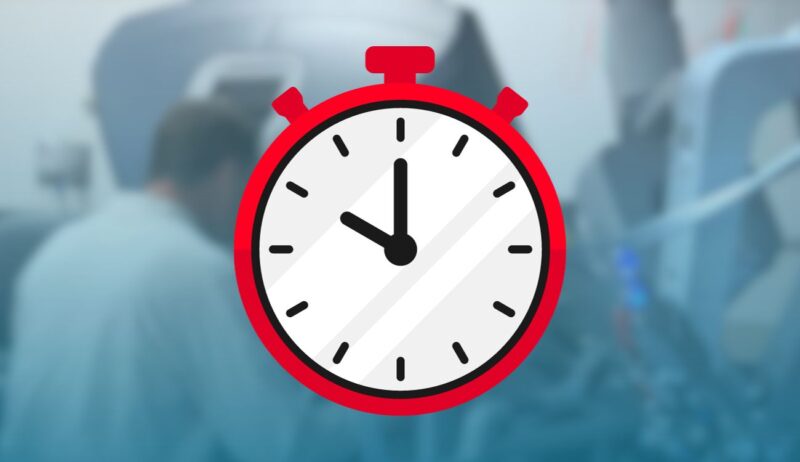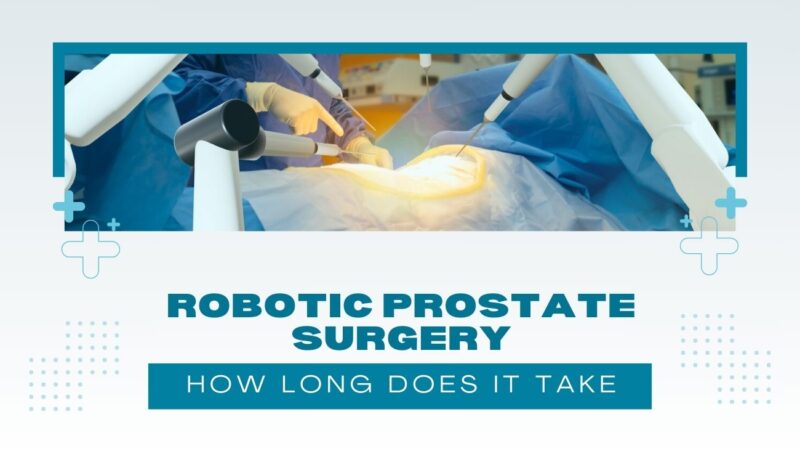In the ever-evolving landscape of medical science, robotic prostate surgery has emerged as a groundbreaking advancement. This state-of-the-art procedure has gained traction in the medical community due to its blend of technology with surgical prowess, promising unparalleled precision, minimized invasiveness, and enhanced patient outcomes.
As more individuals consider this cutting-edge alternative to traditional surgical methods, they often grapple with practical questions. Among the most frequently asked is about the duration of the procedure: Just how long does robotic prostate surgery take?
The Procedure
The essence of robotic interventions in urology focuses on precision and minimization of invasiveness. Specifically, for procedures involving the prostate, a machine with robotic arms, controlled by the surgeon, is used to perform the operation with greater accuracy.
This method not only aids in the treatment of prostate concerns but also often results in quicker recovery times and fewer complications than traditional surgeries. An integral part of understanding this operation is recognizing the steps involved.
From the initial incisions to the removal or treatment of the prostate issue and finally, to the closing stitches, each phase plays a crucial role in determining the overall time of the procedure.
Factors Affecting Duration
Not all robotic-assisted operations for the prostate are identical in length. Several factors can influence the duration, such as:
- The complexity of the case
- The surgeon’s experience with robotic techniques
- Patient health and anatomy
While some procedures may only last a couple of hours, others can extend for a more extended period, especially if complications arise. It’s essential to consult with medical professionals for a personalized estimate based on individual circumstances.
Typical Duration

With a basic understanding of robotic procedures under our belt, let’s focus on the average time these operations take. As mentioned, various factors can influence duration, but some general guidelines and expectations can help patients prepare.
Average Time Frame
On average, robotic-assisted operations on the prostate can take anywhere from 2 to 4 hours. This estimate encompasses the entire procedure, from the first incision to the last stitch. The time frame is purely operational, and patients should also account for pre-operation preparation and post-operation recovery in the hospital.
Here are some general time frames to consider:
| Stage | Duration |
|---|---|
| Pre-operation preparation | 30 min to 1 hour |
| Procedure | 2 to 4 hours |
| Immediate post-op observation | 2 to 4 hours |
It’s worth noting that while the operation itself might seem relatively short, the entire hospital visit can span several hours.
Comparisons with Traditional Procedures
Comparing the time frames of robotic-assisted operations with traditional prostate procedure can offer a clearer perspective. Traditional operations, depending on the method used, might take slightly longer due to the need for larger incisions and the manual nature of the procedure.
Key distinctions include:
- Traditional methods often last between 3 to 5 hours.
- Robotic procedures generally offer quicker recovery, meaning shorter hospital stays.
- The precision of robotic tools might reduce operative time in specific cases.
Post-Operative Considerations

Once the robotic procedure is completed, understanding the immediate aftermath and recovery period becomes crucial. The body’s healing time and steps for post-operative care can vary, but some general insights can guide patients.
Immediate Aftermath
Right after the operation, patients are usually moved to a recovery room for observation. Here, medical professionals monitor vital signs, manage pain, and ensure no immediate complications arise. This period can vary in length, but patients often spend a few hours in recovery before being shifted to a regular room or even discharged.
Some common post-operative experiences include:
- Mild discomfort or pain
- Fatigue from anesthesia
- Need for urinary catheters temporarily
- Recovery at Home
Once discharged, the recovery process continues at home. The exact time frame for complete recovery can range from a few weeks to a couple of months, depending on the individual’s health and the nature of the procedure.
Here are some general recovery guidelines:
- Avoid strenuous activities for several weeks.
- Regularly monitor and clean incision sites.
- Attend follow-up appointments and adhere to medical advice.
- Keeping these guidelines in mind can ensure a smoother healing process and reduce the risk of postoperative complications.
The Advantages of Opting for Robotic Assistance

Beyond the specifics of duration, it’s equally crucial to understand the benefits of opting for a robotic approach when it comes to prostate-related operations. As technology continues to advance, the advantages of this method become increasingly evident, offering patients a safer and more efficient alternative to traditional surgical techniques.
Enhanced Precision and Control
One of the most pronounced advantages of the robotic technique is the unparalleled precision it offers. The machine’s arms can maneuver in ways human hands might find challenging, allowing for intricate procedures in tight spaces with minimal disturbance to surrounding tissues.
The system provides the surgeon with magnified, high-definition, 3D visuals of the operation site. This clarity and detail significantly improve the surgeon’s control over the procedure, leading to more accurate results and potentially fewer complications.
Reduced Trauma and Quicker Recovery
Due to the minimally invasive nature of the robotic procedure, patients often experience reduced trauma. The smaller incisions lead to:
| Benefits |
|---|
| Lesser blood loss |
| Reduced pain post-operation |
| Fewer scars after healing |
As a result, recovery times tend to be quicker compared to traditional methods. Patients can often resume daily activities in a shorter span, leading to a more comfortable post-operative experience.
Potential Challenges and Limitations

While robotic procedures for prostate concerns present many benefits, it’s essential to be aware of potential challenges and limitations. Like any surgical method, it has its set of considerations that patients should be informed about.
Learning Curve for Surgeons
The implementation of robotic techniques does come with a learning curve for medical professionals. Surgeons require specialized training to master the technology and achieve consistent, successful outcomes. Patient outcomes can significantly vary based on the surgeon’s experience with the robotic system.
Thus, when considering this procedure, it’s essential to seek out a medical professional with substantial experience in robotic-assisted operations.
Cost and Accessibility
The advanced technology involved in robotic-assisted procedures often means these operations come with a higher price tag than traditional surgeries. While many healthcare systems and insurance providers are recognizing the benefits and covering the costs, it’s still a concern for some patients.
Not all hospitals and medical centers have access to the necessary robotic equipment. This limitation might require patients to travel to specialized facilities, adding to the overall costs and considerations of the procedure.
Patient Testimonials and Experiences
Beyond the medical specifics and procedural details, hearing directly from those who have undergone robotic-assisted prostate procedures provides invaluable insights. Patient testimonials and experiences can shed light on the real-world impact of these operations and help prospective patients set their expectations.
Positive Outcomes and Faster Recovery
A common thread among many testimonials is the surprise at the rapid recovery times. Many patients report being able to walk within a day of the procedure and return to regular activities within a few weeks. The minimal scarring and reduced pain levels post-operation have also been emphasized by numerous individuals.
The efficiency of the robotic procedure often translates to shorter hospital stays. This factor is not only beneficial for physical recovery but also supports mental well-being, as patients can reintegrate into their familiar environments sooner.
Navigating Potential Hiccups
While a majority of patient experiences lean positive, it’s also essential to recognize the challenges some individuals face. Some patients highlight the initial discomfort associated with urinary catheters or the learning curve in adjusting to bodily changes post-operation.
A few also discuss the mental aspects of undergoing the procedure, such as managing anxiety leading up to the operation or dealing with concerns about post-operative sexual function. Seeking support groups or counseling can be beneficial in navigating these emotional challenges.
Ensuring Optimal Preparation

The success of a robotic-assisted prostate procedure doesn’t solely rest on the operation itself. The preparation leading up to the surgery plays a pivotal role in ensuring optimal outcomes and a smoother recovery process.
Pre-operative Consultations
Prior to the procedure, it’s imperative for patients to engage in comprehensive consultations with their healthcare provider.
| Discussion Points |
|---|
| Medical history and current health conditions |
| Any medications or supplements currently taken |
| Potential risks and complications |
Equally, this is an opportunity for patients to voice any concerns or questions, ensuring they are fully informed and comfortable with the upcoming procedure.
Physical and Mental Preparation
In the days leading up to the operation, patients can undertake certain steps to prime their bodies and minds.
Some suggestions include:
- Engaging in light physical activity to boost overall health
- Following dietary recommendations provided by the medical team
- Seeking relaxation techniques, like meditation or deep-breathing exercises, to manage pre-operative anxiety
Arranging post-operative necessities, such as transportation, in advance These preparatory steps can not only enhance the likelihood of a successful operation but also provide a sense of control and empowerment to patients.
Frequently Asked Questions (FAQs)

Will I be under general anesthesia during the surgery?
Yes, patients are typically under general anesthesia during robotic prostate surgery, ensuring they’re entirely unconscious and pain-free throughout the procedure.
Can all prostate surgeries be done robotically?
While many can benefit from robotic surgery, it’s not suitable for everyone. Factors like the stage of cancer, the prostate’s size, and previous surgical history can influence the decision.
Does robotic surgery affect the risk of post-surgery complications?
Robotic surgery tends to have fewer complications due to its minimally invasive nature. However, as with all surgeries, there’s still a risk of complications, which is why it’s crucial to discuss potential risks with your surgeon.
Are there specific post-operative guidelines for patients who undergo robotic prostate surgery?
General post-operative guidelines include rest, avoiding heavy lifting, and monitoring for signs of infection. However, specific guidelines might vary based on individual cases and surgeon recommendations.
How can I find a surgeon who specializes in robotic prostate surgery?
Many major hospitals and urology centers now offer robotic prostate surgery. It’s essential to research and find a well-reputed, experienced surgeon who has a track record with robotic-assisted procedures.
Summary
Robotic prostate surgery represents a significant leap in the realm of urological treatments. While its benefits are numerous, understanding the duration of the procedure is vital for patient preparedness. The time taken can vary based on several factors, but it’s clear that the efficiency and precision offered by this method are unparalleled.
As medical technology continues to advance, patients can look forward to even more streamlined procedures and quicker recovery times, ensuring they get back to their regular lives with minimal disruption. You can read more interesting medical-related subjects on our website.
